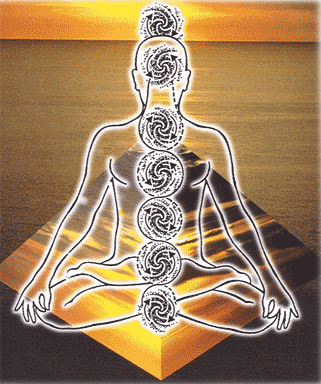

Chakra means Wheel in Sanskrit. The body has energy centers that look like spinning wheels called Chakras. Consciousness and energy move from one frequency to another in spiraling fashion - Fibonacci Sequence. As all things are related and connected, chakras connect with sound light and color.
In metaphysics, you learn that if your chakras are properly aligned you can maintain balance and heal your emotions. That is not exactly true. Energy work is just another way of creating balance as a temporary Band-Aid. Your DNA programming determines how and when and if you heal in the biogenetic experiment in which we exist. Simulation Theory.


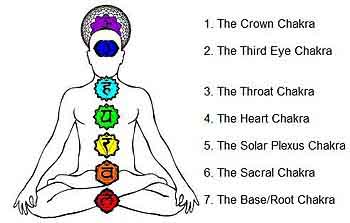
Chakra is a concept referring to wheel-like vortices which, according to traditional Indian medicine, are believed to exist in the surface of the etheric double of man. The Chakras are said to be "force centers" or whorls of energy permeating, from a point on the physical body, the layers of the subtle bodies in an ever-increasing fan-shaped formation. Rotating vortices of subtle matter, they are considered the focal points for the reception and transmission of energies. Different systems posit a varying number of chakras; the most well known system in the West is that of seven chakras.
It is typical for chakras to be depicted as either flower-like or wheel-like. In the former, "petals" are shown around the perimeter of a circle. In the latter, spokes divide the circle into segments that make the chakra resemble a wheel (or "chakra"). Each chakra possesses a specific number of segments or petals.
Texts describing the chakras go back as far as the later Upanishads, for example the Yoga Kundalini Upanishad.
The word comes from the Sanskrit "cakra" meaning "wheel, circle", and sometimes also referring to the "wheel of life". The pronunciation of this word can be approximated in English by 'chuhkruh', with ch as in chart and both instances - the commonly found pronunciation 'shockrah' is incorrect.
The seven main chakras are described as being aligned in an ascending column from the base of the spine to the top of the head. Each chakra is associated with a certain color, multiple specific functions, an aspect of consciousness, a classical element, and other distinguishing characteristics.
The chakras are thought to vitalize the physical body and to be associated with interactions of both a physical and mental nature. They are considered loci of life energy, or prana, which is thought to flow among them along pathways called nadis.
Nadis are thought to carry a life force energy known as prana in Sanskrit, or qi in Chinese-based systems. They are also said to have an extrasensory function, playing a part in empathic and instinctive responses. Nadis are sometimes viewed as extending only to the skin of the body, but are often thought to extend to the boundary of the aura.
The Ida and Pingala nadis are often seen as referring to the two hemispheres of the brain. Pingala is the extroverted, solar nadi, and corresponds to the left hand side of the brain. Ida is the introverted, lunar nadi, and refers to the right hand side of the brain.
The two nadis are stimulated through the practice of pranayama, which involves alternate breathing through left and right nostrils, which would alternately stimulate the left and right sides of the brain.The word nadi comes from the Sanskrit root nad meaning "channel", "stream", or "flow".
Traditional Chinese medicine also relies on a similar model of the human body as an energy system.
The New Age movement has led to an increased interest in the West regarding chakras. Many in this movement point to a correspondence between the position and role of the Chakras, and those of the glands in the endocrine system. Some people in New Age also claim that other chakras, besides the above, exist - for instance, ear chakras.
The chakras are described in the tantric texts the Sat-Cakra-Nirupana, and the Padaka-Pancaka, in which they are described as emanations of consciousness from Brahman, an energy which comes down from the spiritual and gradually crudifies, creating these distinct levels of chakras, and which eventually finds its rest in the Muladhara chakra.
In Samkhya philosophy, the concept of Muladhara is that of moola prakriti, the metaphysical basis of material existence. Muladhara is the chakra that draws down spritual energy and causes it to assume a physical existence. It is like the negative pole in an electrical circuit, which provides the potential for the evolution of form.
Within this chakra resides sleeps the kundalini shakti, the great spiritual potential, waiting to be aroused and brought back up to the source from which it originated, Brahman.
Muladhara is the base from which the 3 main psychic channels, nadis, ida, pingala and sushumna, emerge.It is related to the physical processes of reproduction and excretion, and also to the various fear and guilt complexes associated with them. All a person's Samskaras ( potential karma ), are expressed here, in a physical form.
This chakra is associated with the deities Indra, Brahma and Dakini, the element Earth and the color red.
They are therefore part of an emanationist theory, like that of the kabbalah in the west, or neo-platonism. The energy that was unleashed in creation, called the Kundalini, lies coiled and sleeping, and it is the purpose of a tantric yogi to arouse this energy, and cause it to rise back up through the increasingly subtler chakras, until union with god is achieved in the Sahasrara chakra at the crown of the head.
Apart from this primary text from India, different western authors have tried to describe the chakras, most notably the Theosophists. Many new age writers, such as the Danish author and musician Peter Kjaerulff in his book, The Ringbearers Diary, or Anodea Judith in her book Wheels of Life, have written their opinions about the chakras in great detail, including the reasons for their appearance and their functions.
The seven chakras are said by some to reflect how the unified consciousness of man (the immortal human being or the soul), is divided to manage different aspects of earthly life (body/instinct/vital energy/deeper emotions/communication/having an overview of life/contact to God). The chakras are placed at differing levels of spiritual subtletly, with Sahasrara at the top being concerned with pure consciousness, and Muladhara at the bottom being concerned with matter, which is seen simply as crudified consciousness.
The earliest known mention of chakras is found in the later Upanishads, including specifically the Brahma Upanishad and the Yogatattva Upanishad. These vedic models were adapted in Tibetan Buddhism as Vajrayana theory, and in the Tantric Shakta theory of chakras.It is the shakta theory of 7 main chakras that most people in the West adhere to, either knowingly or unknowingly, largely thanks to a translation of two indian texts, the Sat-Cakra-Nirupana, and the Padaka-Pancaka, by Sir John Woodroffe, alias Arthur Avalon, in a book entitled The Serpent Power.
This book is extremely detailed and complex, and later the ideas were developed into what is predominant western view of the Chakras by the Theosophists, and largely the controversial (in theosophical circles) C. W. Leadbeater in his book The Chakras, which are in large part his own meditations and insights on the matter.
That said, many present-day Indian gurus that incorporate chakras within their systems of philosophy do not seem to radically disagree with the western view of chakras, at least on the key points, and both these eastern and western views have developed from the Shakta Tantra school.
There are various other models of chakras in other traditions, notably in Chinese medicine, and also in Tibetan Buddhism. Even in Jewish kabbalah, the different Sephiroth are sometimes associated with parts of the body.
In Islamic Sufism , Lataif-e-Sitta ( Six Subtleties ) are considered as psychospiritual "organs" or faculties of sensory and suprasensory perception , activation of which makes a man complete .
Attempts are made to try and reconcile the systems with each other, and notably there are some successes, even between such diverged traditions as Shakta Tantra, Sufism and Kabbalism, where chakras , lataif and Sephiroth can seemingly represent the same archetypal spiritual concepts.
In Surat Shabda Yoga, initiation by an Outer Living Satguru (Sat - true, Guru - teacher) is required and involves reconnecting soul to the Shabda and stationing the Inner Shabda Master (the Radiant Form of the Master) at the third eye chakra.
Parallels have often been drawn, by supporters of the existence of chakras, between the positions and functions of the chakras, and of the various organs of the endocrine system.
The highest crown chakra is said to be the chakra of consciousness, the master chakra that controls all the others. Its role would be very similar to that of the pituitary gland, which secretes hormones to control the rest of the endocrine system, and also connects to the central nervous system via the hypothalamus. The thalamus is thought to have a key role in the physical basis of consciousness.
The Ajna Chakra, or third eye, is linked to the pineal gland. Ajna is the chakra of time and awareness and of light. The pineal gland is a light sensitive gland, that produces the hormone melatonin, which regulates the instincts of going to sleep and awakening. It also produces trace amounts of the psychedelic chemical dimethyltryptamine.
(Note: some argue that the pineal and pituitary glands should be exchanged in their relationship to the Crown and Brow chakras, based on the description in Arthur Avalon's book on kundalini called Serpent Power)
The throat chakra, Vishuddha, is said to be related to communication and growth, growth being a form of expression. This chakra is paralleled to the thyroid, a gland that is also in the throat, and which produces thyroid hormone, responsible for growth and maturation.
The heart chakra, Anahata, is related to love, equilibrium, and well-being. It is related to the thymus, located in the chest. This organ is part of the immune system, as well as being part of the endocrine system. It produces T cells responsible for fighting off disease, and is adversely affected by stress.
The solar plexus chakra, Manipura, is related to energy, assimilation and digestion, and is said to correspond to the roles played by the pancreas and the outer adrenal glands, the adrenal cortex. These play a valuable role in digestion, the conversion of food matter into energy for the body.
The sacral chakra, Swadhisthanna, is located in the groin, and is related to emotion, sexuality and creativity. This chakra is said to correspond to the testes or the ovaries, that produce the various sex hormones involved in the reproductive cycle, which can cause dramatic mood swings.
The base or root chakra, Muludhara, is related to security, survival and also to basic human potentiality. It is said the kundalini lies coiled here, ready to uncoil and bring man to his highest spiritual potential in the crown chakra. This center is located in the region between the genitals and the anus. Although no endocrine organ is placed here, it is said to relate to the inner adrenal glands, the adrenal medulla, responsible for the fight and flight response when survival is under threat. In this region is located a muscle that controls ejaculation in the sexual act. A parallel is drawn between the sperm cell and the ovum, where the genetic code lies coiled, and the legendary kundalini, ready to express itself as a fully developed human being.
Chakrology is a neologism sometimes employed by Alternative Medicine practitioners or esoteric philosophers for the study of chakras. There are many different chakrologies, some of them based on ancient Indian Hindu Tantric esoteric traditions, New Age interpretations, or Western occult analyses, as well as ancient Greek and Christian references. Croatian esoteric philosopher and physicist Arvan Harvat notes that it would be very difficult to develop a unified coherent chakra science that would integrate all the elements of the various present chakrologies.
The idea of chakras as understood in Eastern philosophy does not exist in Western medical science. In Eastern thought, the chakras are thought to be levels of consciousness, and states of the soul, and 'proving' the existence of chakras is akin to 'proving' the existence of a soul. A mystic deals with these metaphysical concepts on the metaphysical plane, as a model for their own internal experience, and when talking about 'energy centres', they are generally talking about subtle, spiritual forces, which work on the psyche and spirit, not about physical electrical or magnetic fields.
The primary importance and level of existence of chakras is therefore posited to be in the psyche and in the spirit. However, there are those who believe that chakras have a physical manifestation as well. Although there is no evidence that Indian mystics made this association themselves, it is noted by many that there is a marked similarity between the positions and roles described for chakras, and the positions and roles of the glands in the endocrine system, and also by the positions of the nerve ganglia (also known as "plexuses") along the spinal column, opening the possibility that two vastly different systems of conceptualization have been brought to bear to systemize insights about the same phenomenon. By some, chakras are thought of as having their physical manifestation in the body as these glands, and their subjective manifestation as the associated psychological and spiritual experiences.
Indeed, the various hormones secreted by these glands do have a dramatic effect on human psychology, and an imbalance in one can cause a psychological or physical imbalance in a person. Whether these changes in body state have a bearing on spiritual matters is a subject of dissent even among the Indian theorists, and the different systems of conceptualization, Indian and Western, make only a partial convergence in this case.
Perhaps the most psychologically dramatic and potent secretion of these glands is the psychedelic drug DMT (which is synthesized by the pineal gland, corresponding to the brow chakra). At least in the West, some individuals have sought spiritual breakthroughs through the use of such chemical aids, occasionally referred to as entheogens in this context.

Here is a simple exercise you can do using a Pendulum or anything that substitutes for a pendulum.
Stand facing another person. Take the pendulum and hold it above their Crown Chakra and note the circular direction it takes. (The pendulum may move side to side instead of in circles, but that's okay.)
Next place the pendulum in front of the person's Third Eye Chakra. The pendulum should change direction - from clockwise to counterclockwise (or from side to side to front to back.)
When ready ... Stop the pendulum.
Now place the pendulum on the Throat Chakra, and the pendulum should swing as it did with the Crown Chakra.
When ready ... Stop the pendulum.
The Heart Chakra should match the Third Eye... on so on.
When ready ... Stop the pendulum.
If a person's chakras are balanced the pattern will clearly follow. If there is an area where the pendulum does not move properly, then one must look at the emotional and physical issues attached to that chakra.
Enjoy.
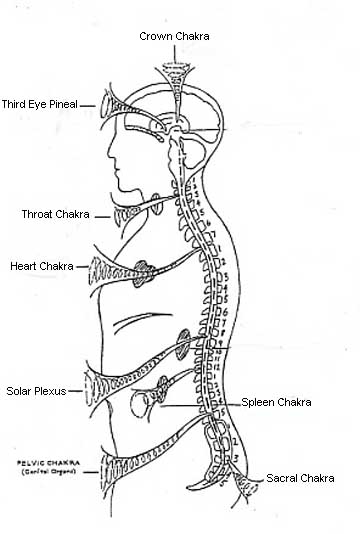
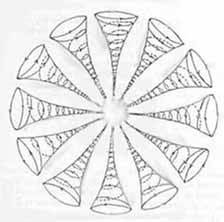
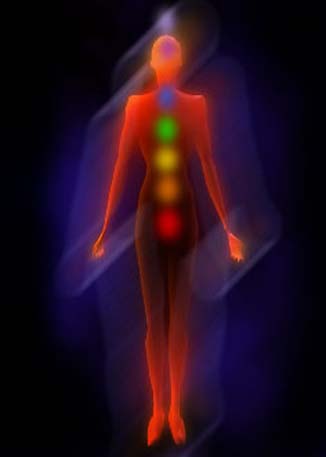
RED
1st Chakra: Base or Root Chakra: Kundalini: Root Chakra:
Located at the base of the spine.
Earth, survival, grounding, stillness
Contains the primary 8 cells that have all of the knowledge of
creation and remain the only cells in your body that do not
change in your lifetime. It grounds us in the physical world.
ORANGE
2nd Chakra: Spleen: Located just beneath the navel, and
related to our sexual and reproductive capacity.
Blockage manifests as emotional problems or sexual guilt.
YELLOW
3rd Chakra: Solar Plexis: Seat of Emotions. Gives us a sense of personal
power in the world. Blockage manifests as anger or a sense of victimization.
GREEN
4th Chakra: Heart Chakra: Blockage can manifest as immune
system or heart problems, or a lack of compassion.
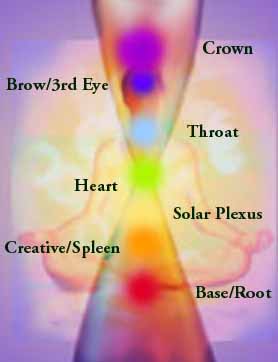
Heart Center - Seat of the Soul in the hourglass of time - Zero Point
BLUE
5th Chakra: Throat: Tied to creativity and communication.
Feels pressure when you are not communicating your emotions properly.
INDIGO
6th Chakra: Third Eye Pineal Gland:
Often connected to the forehead.
Is a physical eye at the base of the brain
with the capabilities of looking upward.
Clairvoyance, psychic abilities, imagination, dreaming
PURPLE
7th Chakra Crown: Connects you with message from higher realms.
Can be experienced as a pressure on the top of the head.
spiritual connection, understanding, knowing, bliss, God
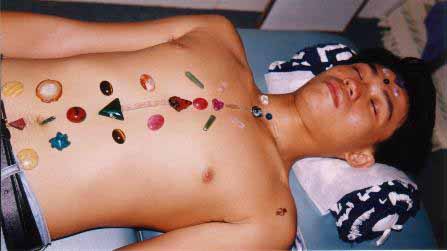

| | Chakra | Color | |
| Crown | Violet | ||
| Third Eye / Brow | Indigo | ||
| Throat | Blue | ||
| Heart | Green | ||
| Solar | Yellow | ||
| Sacral | Orange | ||
| Base | Red |
Tantra (Shakta or Shaktism) describes eight primary inner chakras:
2. Ajna
3. Vishuddha
4. Anahata
5. Manipura
6. Swadhisthana
7. Muladhara
8. Bindu
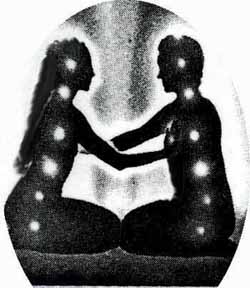
Lovers connecting their chakras
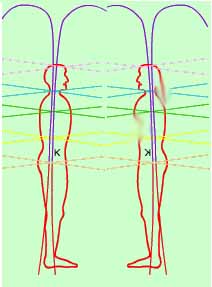
grid matrixes and auric fields.
Body, Mind and Soul
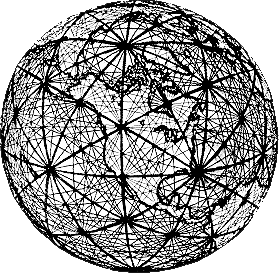
The Earth, as a living organism, has chakra centers.
They link with major grid points.
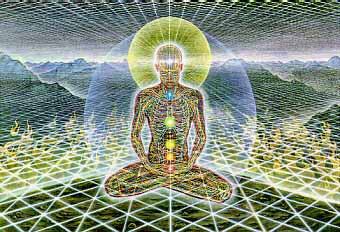
Our chakras are aligned to the Earth's grid system.